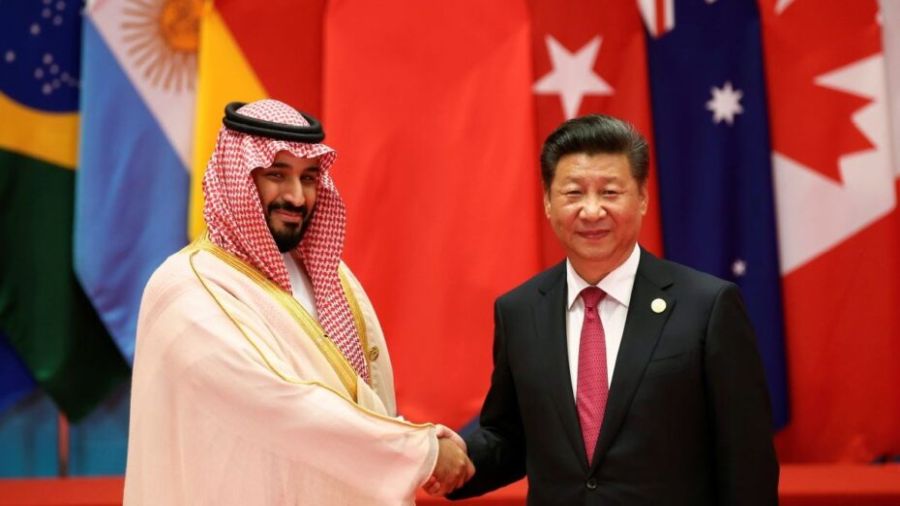China’s BRI Shapes a Multipolar Future for Saudi Arabia
Xi Jinping’s visit to Saudi Arabia is heralding more tectonic changes in the rules of the Great Game in ways that few have begun to realize.
While many people are quick to criticize China for having looked the other way while the atrocious Saudi-led offensive in Yemen has continued to kill hundreds of thousands of civilians since 2015, these same people miss the fact that a higher geopolitical reality is being born which will have a much greater benefit to both the people of Yemen and humanity more generally if it is not sabotaged.
Just to be clear: Saudi Arabia has a lot of blood on her hands.
However, the monarchy is also not merely the unidimensional player which many often assume whose goal is to simply bask forever in oil profits while spreading wahhabite radicalism across the Arab world while subduing any nation who stands in their way.
There is also an emergent robust young generation in Saudi Arabia (half of the 31 million Saudis are under 25) and a renewed embrace of advanced technological progress as a driver for a post-hydrocarbon age. This more healthy dynamic within the Saudi population and governing class was outlined clearly in the Saudi Vision 2030 program of April 2016 and earlier the January 2016 Joint Statement between the People’s Republic of China and the Kingdom of Saudi Arabia which read: “In the process of jointly pursuing the Silk Road Economic Belt and the 21st Century Maritime Silk Road initiative, China is willing to coordinate development strategies with Arab states, put into play each other’s advantages and potentials, promote international production capacity cooperation and enhance cooperation in the fields of infrastructure construction, trade and investment facilitation, nuclear power, space satellite, new energy, agriculture and finance, so as to achieve common progress and development and benefit our two peoples.”
This positive orientation can be seen by an array of common sense transformations of the Saudi foreign policy priorities over recent years made possible by the smooth diplomacy of both China and Russia who are leading in the creation of a new viable security/financial architecture far outside of the control of western unipolarists. Among the chief of these new priorities is a focus on vectoring east towards a pro-China policy, and improving diplomatic relations with historic enemies within the region.
Rebuilding Relationships and Stability in the Middle East
In November 2020, Saudi Arabia and Iraq re-opened their borders and began restoring cooperative ties 30 years after Saddam’s invasion of Kuwait saw a near total cutting off of relations. Saudi Arabia and Turkey (both of whom having suffered from overlapping spheres of interest within the Middle East) have also gone far to reset their relations with Erdogan and Crown Prince Bin Salman announcing a “new era of cooperation” after the latter’s visit to Ankara. In their joint communique, Saudi Arabia and Turkey wrote of “their common determination to enhance cooperation in the bilateral relations between the two countries including in the political, economic, military, security and cultural fields.”
It wasn’t three days after this meeting that Iraqi Prime Minister Mustafa al-Kadhimi met with the Crown Prince in Jeddah where matters of economic, regional stability, “bilateral relations and opportunities for joint cooperation” was discussed (followed by the Iraqi PM’s meeting with his Iranian counterparts a day later). Iran and Iraq are currently in the final stages of work on the first rail connection between the two states in history with the Shalamcheh-Basra rail line that can easily connect to the existent 1500 km railway across Iraq and could then easily stretch into Syria and Lebanon as part of the Southern corridor of the BRI.
Iran and Saudi Arabia have also sped up their efforts to rebuild diplomatic ties after the disastrous execution of Shiite cleric Nimr-al-Nimr caused the total rupture of ties in 2016. Other gulf states who had also cut ties with Iran such as UAE and Kuwait have already restarted relations. It is this author’s contention that this breakthrough would have been entirely impossible were it not for the fact that both China and Russia have made it clear that Iran is an integral pillar of the Greater Eurasian Partnership, playing a potential stabilizing role in the middle east, as well as a key node in the functionality of both the International North South Transportation Corridor and also the southern route of the Belt and Road Initiative.

This turn towards rationality by Saudi Arabia makes perfect sense.
The western overlord of the Middle East who have used Saudi Arabia and other regimes as weapons in their geopolitical arsenal of oil geopolitics and the creation/deployment of terrorism have made it clear that the “post-Great Reset” rules based international order sees little room for hydrocarbon fuels which have been deemed “enemy #1” to be destroyed at all cost in the pursuit of “global net zero” by 2050. As such, even on a practical level, there will be very little role which Saudi Arabia or any other oil-reliant state will play within this utopic new order.
A Sane Energy Policy
China, on the other hand, has no such delusional green visions and instead offers a more rational energy vision with its partners outlined in the August 2022 Memorandum of Understanding signed by Saudi’s Aramco and China’s Sinopec to vastly expand cooperation on petrochemical integration, engineering, construction, up and downstream technology and hydrogen production. The head of Aramco even said: “Ensuring the continuing security of China’s energy needs remains our highest priority – not just for the next five years but for the next 50 and beyond.”
Ever since Saudi Arabia first floated the idea of selling oil to China in yuan rather than U.S. dollars back in March 2022, it has become increasingly clear that the age of the U.S. dollar as the sole reserve currency is quickly coming to an end. Since 2016 Sino-Saudi trade has expanded massively with China becoming Saudi Arabia’s primary trade partner with bilateral trade hitting $87 billion in 2021. Meanwhile China purchases over 25% of all the oil Saudi Arabia produces.
On a deeper level which touches on the substance of long term successful survival (vs mere momentary pragmatic tactical survival), Saudi Arabia has increasingly come to the realization that it needs a new way of doing things. The age of oil geopolitics shaped by speculative spot and futures markets as it was played since 1973 is by all intents and purposes over and anyone wishing to continue playing by those rules will not survive for long. The new reality setting the tone for the Middle East is based upon real, measurable growth with a focus on interconnectivity, rail, and industrial corridors. The prices of oil and other commodities is increasingly being set by the measurable needs of nations and people, instead of the myopic impulses of speculators obsessed with making money and no concern for the real world.
As such, it makes perfect sense that China has worked so hard to help Saudi Arabia become the second nuclear powered gulf state (following the UAE’s recent leap into the 21st century with 2.7 GW of energy now constructed as of this writing).
As early as 2016, China signed an MOU to help Saudi Arabia build 4th generation gas cooled reactors and in 2020 Chinese companies signed an agreement to help Saudi Arabia not only utilize its vast uranium resources but also become proficient in all aspects of the nuclear fuel cycle. This would be vital not only to help Saudi Arabia successfully transition off of its reliance on hydrocarbons, but would also create vast new reservoirs of oil for the global markets now desperately in need of fuel. The vast opportunities for mass desalination is yet another reason why nuclear is the obvious choice for any nation seriously thinking about overcoming water scarcity in sustainable ways.
Interconnectivity Grows
Besides the $500 billion NEOM megacity on the Red Sea which Xi will be visiting shortly, the Saudi Vision 2030 has also made the construction of several megaprojects a high priority such as the 450 km high speed Haramain Railway completed by China Railway Construction Corporation linking Mecca to Medina. This project provides a solid extension to the 2700 km north-south railway completed in 2015 which connects Riyadh to Al Haditha on Jordan’s border. An additional 460 km of railways connecting various GCC members is also being built.

Additionally, the $200 billion Persian Gulf-Red Sea high speed railway (aka: Saudi Land bridge) received full support from all six Gulf Cooperation Council members in 2021 which will see a 2100 km high speed railway stretch across the Arabian Desert with branches that could easily extend north into Egypt where similar projects are already underway and south into Yemen and beyond through the 26 km Bal el-Mandeb Strait across the Red Sea into East Africa. If a successful peace process can endure between Saudi Arabia and Yemen, and if Iran can be brought into a mediating role, it is entirely feasible that this project dubbed “The Bridge of the Horn of Africa” when it was first unveiled in 2009, may finally see the light of day.
During the 14th century, European artists noted that oil and water cannot be mixed without a third element of egg tempura serving as a medium whereby an array of pigments arriving from as far as Arabia and even Asia, could be turned into paint. In this same way, China and to a large extent Russia have become this “third medium” which has made antagonistic political interests across the Middle East harmonize under a new paradigm of cooperation and trust. A potentially beautiful new future driven by the re-awakening of the spirit of the Silk Road is being painted before our eyes.







